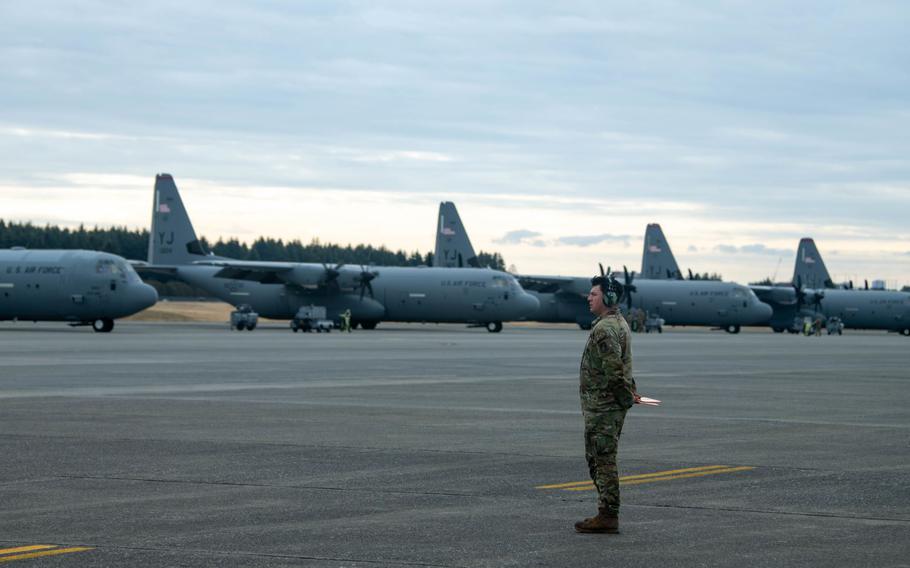Spotlight!
Keeping Airborne 24 Soaring: Inside the crucial work of 374th AMXS
374th Airlift Wing Public Affairs March 12, 2024

U.S. Air Force Senior Airman Giovanni Elias, 374th Aircraft Maintenance Squadron flight crew chief, waits to marshal a C-130J Super Hercules assigned to the 36th Airlift Squadron during exercise Airborne 24 at Yokota Air Base, Japan, March 7, 2024. Elias’s role as a flight crew chief is to oversee the launch, recovery, inspection, troubleshooting and maintenance of aircraft under their charge. (Airman 1st Class Alexzandra Gracey, U.S. Air Force)
YOKOTA AIR BASE, Japan -- Amidst the deafening roars of C-130J Super Hercules engines from the Yokota flightline, the 374th Aircraft Maintenance Squadron stands as the faithful backbone of aircraft operability, ensuring mission readiness from the ground up for exercise Airborne 24.
Airmen of the 374th AMXS work both day and night to get aircraft off the ground safely and efficiently. These Airmen fall within six different job categories that all work cohesively to maintain the overall operability and mission-readiness of the multiple C-130J aircrafts assigned to the 374th Airlift Wing.
With jobs ranging from aircraft hydraulic technicians to avionic electronics specialists and flight crew chiefs, AMXS Airmen are vital to the success of any mission involving aircraft, and that fact remains the same for exercise Airborne 24.
Airborne 24 is the largest, static-line paratrooper jump training exercise that involves both the U.S. Air Force and Japan Ground Self-Defense Force. This annual event aims to improve bilateral coordination, strengthen alliances, and increase operational efficiency throughout the Indo-Pacific region. Tactical precision is imperative from all units involved in Airborne 24, but the exercise is kicked off with the surge of six C-130Js, generated by Yokota maintainers.
“For this aircraft generation event, we’re having a multitude of groups come together,” Senior Airman Giovanni Elias, 374th AMXS flight crew chief. “A lot of our maintenance team is going to be there. The whole point of the aircraft generation event is for AMXS to have a 100-percent mission capability rate. It shows that it’s possible to do, and that we’re capable of anything.”
In order for the approximately 300 JGSDF paratroopers to be transported to the drop zone at Kikaijima Island, Japan, AMXS needed to have the C-130Js ready to fly without any setbacks. According to Elias, AMXS will begin their extensive work at least three hours before anyone else arrives. Maintainers meticulously run through checklists of safety and performance procedures for every aircraft, ensuring everything is functioning for the scheduled departure time.
“Exercises like these are important because they show that our airmen can get the job done,” said Elias. “They’re being introduced to how a real-world mission goes. It helps teamwork and communication between everyone.”
Airborne 24 also serves as a beneficial experience for maintainers of all skill levels, extending beyond just their day-to-day job.
“This exercise puts our Airmen in a high stress environment, training them how to operate effectively,” said Tech. Sgt. Reuben Bowers, 374th AMXS flightline expeditor. “They’re put in the mindset of getting to the next level and trying to become the best at their job.”
While Airborne 24 is centered around impressive paratroopers jumping from the back of C-130Js, it’s the maintainers that enable mission large-scale operations to transpire. Without their consistent dedication to maintaining operability and mission readiness, exercises like these simply wouldn’t have the ability to take flight.